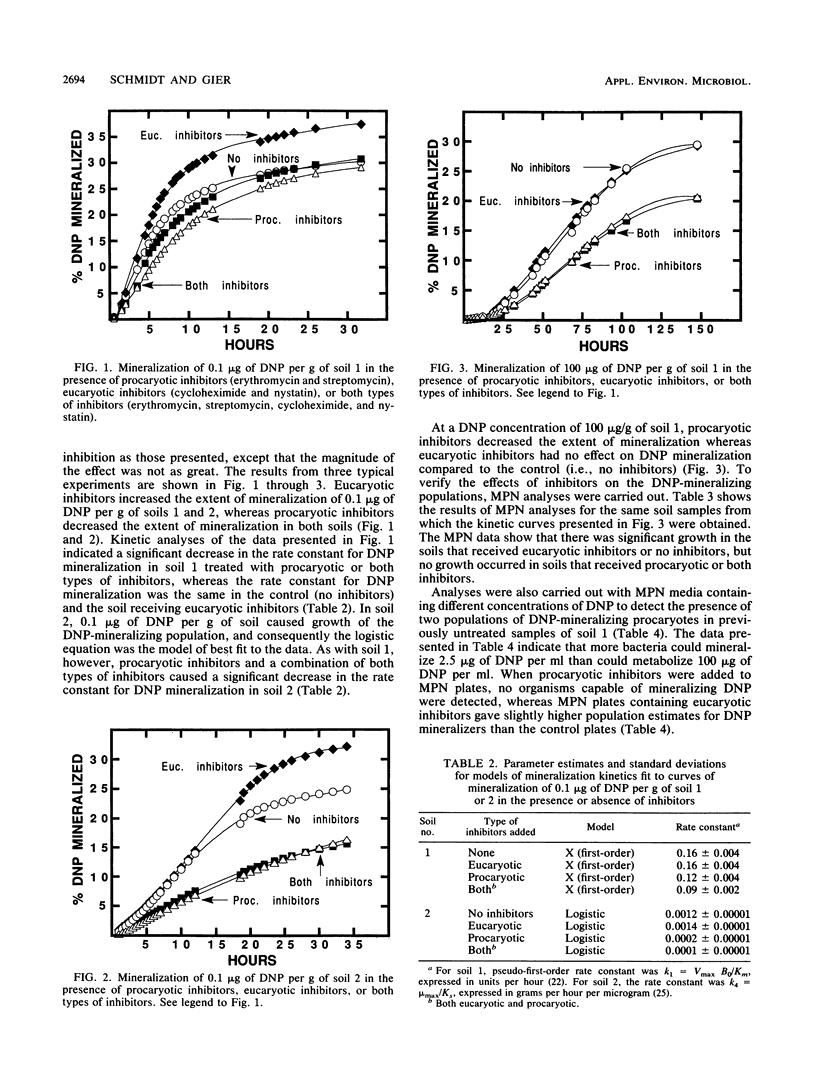Abstract
Experiments were conducted to study populations of indigenous microorganisms capable of mineralizing 2,4-dinitrophenol (DNP) in two soils. Previous kinetic analyses indicated the presence of two coexisting populations of DNP-mineralizing microorganisms in a forest soil (soil 1). Studies in which eucaryotic and procaryotic inhibitors were added to this soil indicated that both populations were bacterial. Most-probable-number counts with media containing different concentrations of DNP indicated that more bacteria could mineralize low concentrations of DNP than could metabolize high concentrations of it. Enrichments with varying concentrations of DNP and various combinations of inhibitors consistently resulted in the isolation of the same two species of bacteria from soil 1. This soil contained a large number and variety of fungi, but no fungi capable of mineralizing DNP were isolated. The two bacterial isolates were identified as a Janthinobacterium sp. and a Rhodococcus sp. The Janthinobacterium sp. had a low μmax and a low Km for DNP mineralization, whereas the Rhodococcus sp. had much higher values for both parameters. These differences between the two species of bacteria were similar to differences seen when soil was incubated with different concentrations of DNP. Values for μmax from soil incubations were similar to μmax values obtained in pure culture studies. In contrast, Ks and Km values showed greater variation between soil and pure culture studies. The results of this study help to confirm predictions that two physiologically distinct bacterial populations are responsible for the multiphasic mineralization kinetics observed in the soil studied.
Full text
PDF





Selected References
These references are in PubMed. This may not be the complete list of references from this article.
- Anderson J. P., Domsch K. H. Measurement of bacterial and fungal contributions to respiration of selected agricultural and forest soils. Can J Microbiol. 1975 Mar;21(3):314–322. doi: 10.1139/m75-045. [DOI] [PubMed] [Google Scholar]
- Button D. K. Evidence for a terpene-based food chain in the gulf of alaska. Appl Environ Microbiol. 1984 Nov;48(5):1004–1011. doi: 10.1128/aem.48.5.1004-1011.1984. [DOI] [PMC free article] [PubMed] [Google Scholar]
- Focht D. D., Shelton D. Growth kinetics of Pseudomonas alcaligenes C-0 relative to inoculation and 3-chlorobenzoate metabolism in soil. Appl Environ Microbiol. 1987 Aug;53(8):1846–1849. doi: 10.1128/aem.53.8.1846-1849.1987. [DOI] [PMC free article] [PubMed] [Google Scholar]
- HARDIN G. The competitive exclusion principle. Science. 1960 Apr 29;131(3409):1292–1297. doi: 10.1126/science.131.3409.1292. [DOI] [PubMed] [Google Scholar]
- Hess T. F., Schmidt S. K., Silverstein J., Howe B. Supplemental substrate enhancement of 2,4-dinitrophenol mineralization by a bacterial consortium. Appl Environ Microbiol. 1990 Jun;56(6):1551–1558. doi: 10.1128/aem.56.6.1551-1558.1990. [DOI] [PMC free article] [PubMed] [Google Scholar]
- Lewis D. L., Hodson R. E., Freeman L. F. Multiphasic kinetics for transformation of methyl parathion by flavobacterium species. Appl Environ Microbiol. 1985 Sep;50(3):553–557. doi: 10.1128/aem.50.3.553-557.1985. [DOI] [PMC free article] [PubMed] [Google Scholar]
- Lewis D. L., Hodson R. E., Hwang H. M. Kinetics of mixed microbial assemblages enhance removal of highly dilute organic substrates. Appl Environ Microbiol. 1988 Aug;54(8):2054–2057. doi: 10.1128/aem.54.8.2054-2057.1988. [DOI] [PMC free article] [PubMed] [Google Scholar]
- Matin A., Veldkamp H. Physiological basis of the selective advantage of a Spirillum sp. in a carbon-limited environment. J Gen Microbiol. 1978 Apr;105(2):187–197. doi: 10.1099/00221287-105-2-187. [DOI] [PubMed] [Google Scholar]
- Robinson J. A., Tiedje J. M. Nonlinear estimation of Monod growth kinetic parameters from a single substrate depletion curve. Appl Environ Microbiol. 1983 May;45(5):1453–1458. doi: 10.1128/aem.45.5.1453-1458.1983. [DOI] [PMC free article] [PubMed] [Google Scholar]
- Rowe R., Todd R., Waide J. Microtechnique for most-probable-number analysis. Appl Environ Microbiol. 1977 Mar;33(3):675–680. doi: 10.1128/aem.33.3.675-680.1977. [DOI] [PMC free article] [PubMed] [Google Scholar]
- Schmidt S. K., Scow K. M., Alexander M. Kinetics of p-nitrophenol mineralization by a Pseudomonas sp.: effects of second substrates. Appl Environ Microbiol. 1987 Nov;53(11):2617–2623. doi: 10.1128/aem.53.11.2617-2623.1987. [DOI] [PMC free article] [PubMed] [Google Scholar]
- Schmidt S. K., Simkins S., Alexander M. Models for the kinetics of biodegradation of organic compounds not supporting growth. Appl Environ Microbiol. 1985 Aug;50(2):323–331. doi: 10.1128/aem.50.2.323-331.1985. [DOI] [PMC free article] [PubMed] [Google Scholar]
- Scow K. M., Simkins S., Alexander M. Kinetics of mineralization of organic compounds at low concentrations in soil. Appl Environ Microbiol. 1986 May;51(5):1028–1035. doi: 10.1128/aem.51.5.1028-1035.1986. [DOI] [PMC free article] [PubMed] [Google Scholar]
- Simkins S., Alexander M. Models for mineralization kinetics with the variables of substrate concentration and population density. Appl Environ Microbiol. 1984 Jun;47(6):1299–1306. doi: 10.1128/aem.47.6.1299-1306.1984. [DOI] [PMC free article] [PubMed] [Google Scholar]
- Stevens T. O., Crawford R. L., Crawford D. L. Biodegradation of Dinoseb (2-sec-Butyl-4,6-Dinitrophenol) in Several Idaho Soils with Various Dinoseb Exposure Histories. Appl Environ Microbiol. 1990 Jan;56(1):133–139. doi: 10.1128/aem.56.1.133-139.1990. [DOI] [PMC free article] [PubMed] [Google Scholar]


